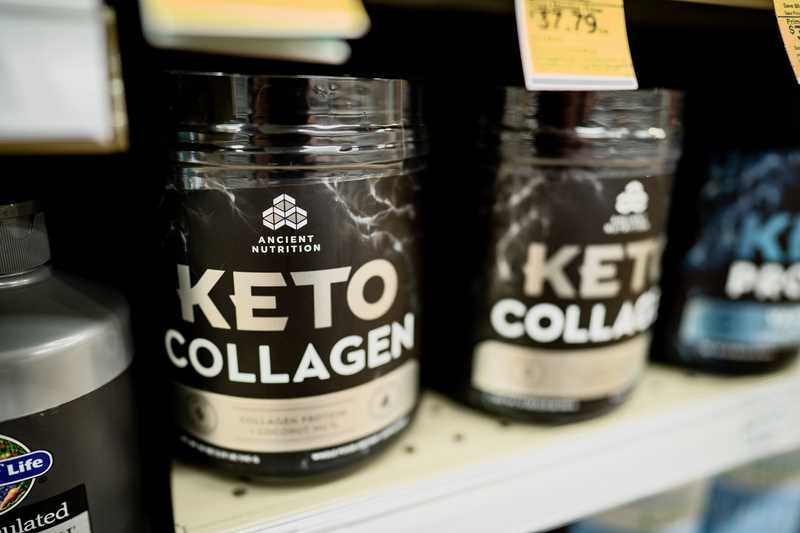Did you read that title and think, "Good heavens I hope not!" You may already know that fancy coffee drinks are not great for your wallet, but for many people they are wreaking havoc on their joints too. Unfortunately, there might be some truth to the idea that sugar is causing your knee pain.
Coffee, and what you put in it, like milk or sugar, each act differently in our bodies. Unfortunately, each one may be affecting your level of inflammation, which can affect your level of joint pain. As promised in our introduction to foods that cause joint pain (like a latte), this 3-part series will dive into each component of your morning mocha to uncover why it may be triggering pain, not just in your knees but in any joint of your body.
The average American consumes around 66 pounds of sugar per year.1 And this is considered a conservative estimate! In this post, Part 1 of our latte series, we start by looking at how sugar impacts knee pain.
Table of Contents
- Understanding the Sugar in Your Latte
- Is Sugar Causing Your Knee Pain?
- How Much Sugar Does Your Body Actually Need?
- How Much Sugar is in Your Coffee?
- Blood Sugar Spikes and Your Joints
- How to Limit Your Sugar and Reduce Knee Pain
- How Can a Latte Loving Person Reduce Pain?
- How to Reduce Your Sugar Intake Without Feeling Deprived
Understanding the Sugar in Your Latte
I think by now we all know sugar, or other derivatives like fructose corn syrup, is not good for us. The real question though is WHY isn’t it good for us? Many of us associate sugar with gaining weight. However, there are a lot of other sneaky side effects that you may not even be thinking about. I know sugar is delicious and it can feel impossible to avoid. Yet, learning to be in control of your sugar intake, rather than the other way around, is huge for your overall health and joint pain!
Is Sugar Causing Your Knee Pain?
Excess sugar in any form creates inflammation in our bodies. For some people, that shows up as joint pain. Too much sugar and chronic inflammation can also lead to a whole slew of symptoms such as mood disorders, fatigue, and digestive issues.
While research demonstrates that a low sugar diet can significantly reduce an individual’s inflammation, it is less clear as to why it causes it in the first place.2 The most promising theories surround the way our bodies digest excess sugar, resulting in compounds (such as free radicals) that damage our tissues. Imagine free compounds bouncing around in your tissues like they do in a pinball machine—ouch!
With all this in mind, do you know what has a lot of added sugar? A deliciously fancy drink from your local coffee shop!
How Much Sugar Does Your Body Actually Need?
We normally have about 1 tsp of sugar floating around in our blood stream in the form of glucose. Our body uses this to power our brain, our organs, and our muscles. When we eat (or drink) foods containing carbohydrates, they are digested and broken down into their single sugar components: glucose, fructose, and galactose.
When these sugars enter our bloodstream, they increase our blood sugar level. You can see this for yourself by using a blood glucose monitor (glucometer), often used by diabetics.
Let's look at a healthy blood sugar level
When we first wake up in the morning, an optimal fasting blood sugar is 70-95 mg/dl, but most health organizations will give a little more leeway and say 100 mg/dl.
Now, let’s pretend you have gotten up, showered and driven to your favorite coffee shop to grab a mocha latte before heading to work, or these days, back to your new quarantine home office.
That 16oz mocha contains 370 calories, 43g of carbohydrate, 35g of which are from added sugar. The remaining 8g are from lactose, the sugar found in milk. Does that seem like a lot of sugar to you?
How Much Sugar is in Your Coffee?
Let’s put this in perspective. 43g of carbohydrate is equal to 10.75 tsp of sugar. The American Heart Association3 recommends no more than 6-9 tsp of added sugar daily. Since liquids are so easily digested and absorbed, I can almost guarantee that if we checked your blood sugar levels, we would see a dramatic increase from your fasting level of 70-95 up to 130, 150, maybe even 180 mg/dl or higher.
According to the International Diabetes Federation (IDF) guidelines for managing post-meal glucose levels4, non-diabetic individuals should have a blood glucose level no higher than 140 mg/dl after meals, and glucose should return to pre-meal levels within 2-3 hours. Hopefully back below 100 mg/dl.
From a sugar high to a major energy slump
After drinking your mocha how do you feel? Probably energized and focused for a short time. But within an hour are you tired, cranky, and hungry? As your blood sugar spikes you might get an initial hit of energy, but as it continues to climb and then crash down, you will likely feel the effects in the form of a mid-morning slump.
Blood Sugar Spikes and Your Joints
When we eat excess carbohydrates or have poorly controlled blood sugar, our bodies create a compound called Advanced Glycation End-products (AGEs). It’s a great acronym since AGEs actually speed up the aging process (aka more wrinkles, aches, and forgetfulness). What happens is the soft tissues slowly breakdown due to aging from AGEs. This includes the soft tissue cartilage between our bones, and the tendons and ligaments that hold everything together. Thus, this breakdown can potentially lead to joint pain.
A report from Nutrition and Metabolism states, "The formation of AGEs can be accelerated under certain conditions, such as hyperglycemia (high blood sugar)…with respect to mobility, AGEs accumulate in bones, joints and skeletal muscles, playing important roles in the development of osteoporosis, osteoarthritis, and sarcopenia [muscle loss] with aging."5
How to Limit Your Sugar and Reduce Knee Pain
You should try your best to limit your sugar and excess carbohydrate consumption. To keep things simple, I teach my patients to look at the total grams of carbohydrate in a food and divide it by 4. This will tell you how many teaspoons of sugar that food will turn into.
You can do this activity with any packaged food in your home to see how much added sugar is in it. Plus, it’s a fun way to get kids involved in learning about nutrition. Have them measure out a portion of their favorite cereal, then help them figure out and measure the number of teaspoons of sugar it turns into in their body.
As mentioned with the mocha latte, 43g / 4 = 10.75 tsp of sugar. Would your mother have let you eat 10.75 tsp of sugar for breakfast? Probably not, but that is effectively what you are doing when you drink one of these fancy coffee drinks.
And don't forget your other breakfast items!
If you choose to grab a blueberry muffin with that latte (or any other processed foods or sugary foods), you now increase your carbohydrate intake by another 49 grams to equal another 12.25 tsp of sugar. AHHH!!!
Over 22g of added sugar? No wonder your knees hurt. This breakfast will send your blood sugar soaring, stimulate the production of AGEs, and keep you in pain.
How Can a Latte Loving Person Reduce Pain?
The ritual of going to your favorite coffee place and greeting your barista is how many of my patients start their day. In this time of so much isolation, I can appreciate how not participating in this ritual might feel even more isolating.
If you still want to grab something fancy from your local coffee shop consider a plain cappuccino or latte. Both are made with just milk and espresso, but in different proportions (cappuccinos are mostly foam, lattes are mostly liquid).
Back before COVID, I enjoyed treating myself to a 16oz almond milk latte on days I went to the office. It came in at only 100 calories, with 10g of carbohydrate, and only 5g from added sugar. HURRAY!
Starting small is best
Maybe this week you ask for 1 pump less of the sugary syrup and then wean yourself down to a plain latte. You might be surprised how your taste buds adapt over time and you’ll find your normal coffee fix way too sweet.
Or be like one of my previous patients who handed her barista a card with her new daily order so she would no longer drink 2 large hot chocolates every day. The staff posted the card behind the register and over time they all watched her chronic pain begin to lift.
How to Reduce Your Sugar Intake Without Feeling Deprived
In theory, reducing your sugar intake to help your joint pain (and other symptoms of "feeling old") is a breeze. In reality, life is messy and sugar tastes good. So if we all know sugar is bad for us, why do we still eat the darn stuff? Simple: Our habits!
Now that you understand how sugar can cause joint pain, or make it worse, you may be feeling ready to make a change. How do you actually start? Use small actionable steps and a lot of support.
Get the support you need
With the right support, you are unstoppable. Without it, it can make reaching your health goals feel impossible. That could be from a friend or family member if they are willing. Otherwise, if that’s not enough (don’t worry, you’re not the only one), we are here for you with professional guidance.
CityPT is here to support your journey to decrease your joint and knee pain. We offer a comprehensive approach that looks at all the factors that might be contributing to your joint pain, such as that extra sugar in your coffee!
What about you? How much sugar is in your morning coffee? Did you know that sugar could be flaring up your joint pain? We'd love to hear from you.
Before you go, please read our disclaimer. This blog is intended for informational purposes only. We are not providing legal or medical advice and this blog does not create a provider-patient relationship. Do not rely on our blog (or any blog) for medical information. Always seek the help of a qualified medical professional who has assessed you and understands your condition.
References
Footnotes
-
How Much is Too Much? Sugar Science. Accessed February 15, 2022. https://sugarscience.ucsf.edu/dispelling-myths-too-much.html#.YgwX9HjMLic ↩
-
Sugar and Inflammation. Medical News Today. Published September 19, 2019. Accessed February 12, 2022. https://www.medicalnewstoday.com/articles/326386#sugar-and-inflammation ↩
-
Added Sugars. Heart.org. Accessed February 17, 2021. https://www.heart.org/en/healthy-living/healthy-eating/eat-smart/sugar/added-sugars ↩
-
2011 Guideline for Management of PostMeal Glucose in Diabetes. International Diabetes Federation. Idf.org. Accessed February 17, 2021. https://www.idf.org/component/attachments/attachments.html?id=728&task=download ↩
-
Chen J-H, Lin X, Bu C, Zhang X. Role of advanced glycation end products in mobility and considerations in possible dietary and nutritional intervention strategies. Nutr Metab (Lond). 2018;15(1):72. https://pubmed.ncbi.nlm.nih.gov/30337945/ ↩

Brenna holds a Master's in Applied Nutrition from Northeastern University in Boston and a Bachelors of Science in Dietetics from Minnesota State University, Mankato. She is passionate about teaching people how foods interact with their body and helping them learn how what they eat affects how they feel.

Brenna holds a Master's in Applied Nutrition from Northeastern University in Boston and a Bachelors of Science in Dietetics from Minnesota State University, Mankato. She is passionate about teaching people how foods interact with their body and helping them learn how what they eat affects how they feel.




